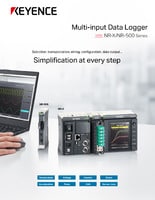Data Acquisition (DAQ)
Temperature & Humidity Data Logger
KEYENCE offers different temperature and humidity data loggers for various applications to help monitor and record changes in these parameters over time. Data obtained through these DAQ systems can be used in environmental monitoring, HVAC system troubleshooting, predictive maintenance, condition monitoring and many more applications.
Key Features of Temperature and Humidity Data Loggers
- Accuracy and Precision: Support for a wide temperature and humidity range means usability in different environments. The system should also have high measurement accuracy. High-speed DAQ should be given consideration, too.
- Data Storage: A data logger device should have sufficient storage capacity so it can record data for as long as required without running out of space. Data should also be stored in a format that's accessible to analysis systems and software.
- Connectivity: To transfer data to a computer, serial ports or USB connections will be required. We have a USB data acquisition system with high-speed data transfer rates for time-sensitive applications.
- Battery Power: Longer battery life makes for extended data collection and minimizes the need for frequent recharging. Our NR-X Series multi-input data logger is capable of collecting 13 hours of data.
- Harsh Environment Immunity: Reducing the number or wires and length of the wires reduces setup time and the possibility of unwanted electrical noise.
How Temperature and Humidity Data Loggers Work
Once a data logger for temperature and humidity is powered on, the sensor responsible for monitoring the parameters is activated, measuring surrounding temperature and humidity levels.
The system logs records at pre-defined rates or intervals and stores measured data electronically in its memory. To retrieve stored data, the logger can be connected to a PC or use a wireless interface for data transfer. Our DAQ NR-500 can be connected directly to a PC, while the Data Logger NR-X has LAN capability. This wireless temperature and humidity data logger makes it easy to easily transfer recorded data between systems.
Applications for Temperature and Humidity Data Loggers
Data loggers find use in different industries. In warehouses, they help monitor storage space conditions to prevent damage to food, pharmaceutical, and electronic products.
For HVAC systems, data acquisition devices log information about temperature and humidity, which are useful for optimizing energy efficiency and ensuring comfortable and healthy indoor environments.
Choosing the Right Data Logger for Your Application
Factors to consider the best temperature and humidity data logger for your needs include:
- Measurement range and accuracy for temperature and humidity readings
- Service life for the battery
- Sampling rate or frequency
- Connectivity
- Environmental resistance
- Ease of use and integration with existing systems
- Acquisition and maintenance costs
Benefits of Using a Temperature and Humidity Data Logger
Using the right data logger, engineers get access to precise measurements required to make accurate product improvements or system changes. The results are:
- Improved efficiency
- Enhanced quality control
- Regulatory compliance
- Data-driven decisions
These real-time data acquisition systems, including modular and portable data acquisition systems, provide time-sensitive measurements and applications.
KEYENCE Temperature and Humidity Data Logger Solutions
We are a leader in the design of data acquisition systems. Whether for temperature and humidity or vibration and sound data acquisition systems, KEYENCE has the right data logger for various needs.
Contact us today.



